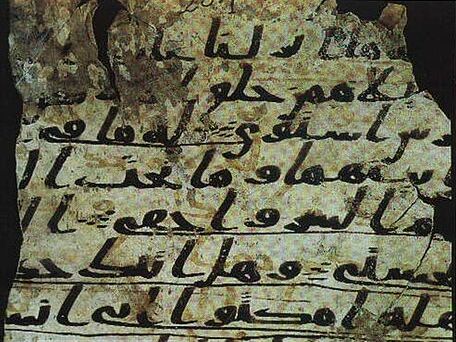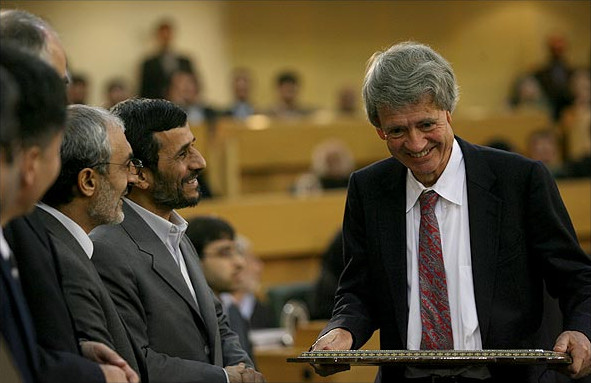|
ŠĻĘan‚ÄėńĀ‚Äô1 Lower Text
The Sanaa palimpsest (also ŠĻĘan ĹńĀ‚Äô 1 or DAM 01-27.1) or Sanaa Quran is one of the oldest Quranic manuscripts in existence. Part of a sizable cache of Quranic and non-Quranic fragments discovered in Yemen during a 1972 restoration of the Great Mosque of Sanaa, the manuscript was identified as a palimpsest Quran in 1981 as it is written on parchment and comprises two layers of text. * The upper text entirely conforms to the standard Uthmanic Quran in text and in the standard order of surahs (chapters). * The lower text, which was erased and written over by the upper text, but can still be read with the help of ultraviolet light and computer processing, contains many variations from the standard text. The sequence of its chapters corresponds to no known Quranic order. A partial reconstruction of the lower text was published in 2012, and a reconstruction of the legible portions of both lower and upper texts of the 38 folios in the Sana'a House of Manuscripts was published in ... [...More Info...] [...Related Items...] OR: [Wikipedia] [Google] [Baidu] |
University Of Hamburg
The University of Hamburg (, also referred to as UHH) is a public university, public research university in Hamburg, Germany. It was founded on 28 March 1919 by combining the previous General Lecture System ('':de:Allgemeines Vorlesungswesen, Allgemeines Vorlesungswesen''), the Hamburg Colonial Institute ('':de:Hamburgisches Kolonialinstitut, Hamburgisches Kolonialinstitut''), and the Academic College ('':de:Akademisches Gymnasium (Hamburg), Akademisches Gymnasium''). The main campus is located in the central district of Rotherbaum, with affiliated institutes and research centres distributed around the city-state. Seven Nobel Prize winners and one Wolf Prize winner are affiliated with UHH. History Founding At the beginning of the 20th century, wealthy individuals made several unsuccessful petitions to the Hamburg Senate and Parliament requesting the establishment of a university. Senator Werner von Melle worked towards the merging of existing institutions into one university, ... [...More Info...] [...Related Items...] OR: [Wikipedia] [Google] [Baidu] |
Stanford University
Leland Stanford Junior University, commonly referred to as Stanford University, is a Private university, private research university in Stanford, California, United States. It was founded in 1885 by railroad magnate Leland Stanford (the eighth List of governors of California, governor of and then-incumbent List of United States senators from California, United States senator representing California) and his wife, Jane Stanford, Jane, in memory of their only child, Leland Stanford Jr., Leland Jr. The university admitted its first students in 1891, opening as a Mixed-sex education, coeducational and non-denominational institution. It struggled financially after Leland died in 1893 and again after much of the campus was damaged by the 1906 San Francisco earthquake. Following World War II, university Provost (education), provost Frederick Terman inspired an entrepreneurship, entrepreneurial culture to build a self-sufficient local industry (later Silicon Valley). In 1951, Stanfor ... [...More Info...] [...Related Items...] OR: [Wikipedia] [Google] [Baidu] |
Behnam Sadeghi
Behnam Sadeghi (born September 16, 1969) is a scholar of Sharia, Islamic law and History of Islam, history. He was assistant professor of religious studies at Stanford University from 2006 to 2016. Biography Sadeghi received his PhD in 2006 from Princeton University. His doctoral dissertation investigated textual interpretation methods used in the Hanafi, Hanafi school of law during the pre-modern period. He has conducted research on the early history of the Quran, Qur'an, Hadith, hadith literature, and early legal debates about women in the public sphere. Works * ''The Logic of Law Making in Islam: Women and Prayer in the Legal Tradition''Reviews of ''The Logic of Law Making in Islam: Women and Prayer in the Legal Tradition'': * * * * * Young, Walter E. "The Logic of Law Making in Islam: Women and Prayer in the Legal Tradition." The Journal of the American Oriental Society, vol. 136, no. 1, January-March 2016, pp. 227+. Gale Academic * * * Review of Middle East Studies, Vol ... [...More Info...] [...Related Items...] OR: [Wikipedia] [Google] [Baidu] |
Qira'at
In Islam, (pl. ; ) refers to the ways or fashions that the Quran, the holy book of Islam, is recited. More technically, the term designates the different linguistic, lexical, phonetic, morphological and syntactical forms permitted with reciting the Quran. Differences between include varying rules regarding the prolongation, intonation, and pronunciation of words, but also differences in stops, vowels, consonants (leading to different pronouns and verb forms), entire words and even different meanings. However, the variations don't change the overall message or doctrinal meanings of the Qur'an, as the differences are often subtle and contextually equivalent. also refers to the branch of Islamic studies that deals with these modes of recitation. There are ten recognised schools of , each one deriving its name from a noted Quran reciter or "reader" ( pl. or ), such as Nafi‚Äė al-Madani, Ibn Kathir al-Makki, Abu Amr of Basra, Ibn Amir ad-Dimashqi, Aasim ibn Abi al-Najud ... [...More Info...] [...Related Items...] OR: [Wikipedia] [Google] [Baidu] |
1924 Cairo Edition
The history of the Quran, the Islamic holy books, holy book of Islam, is the timeline ranging from the inception of the Quran during the lifetime of Muhammad (believed to have received the Quran through revelation between 610 and 632 CE), to the emergence, transmission, and Canonization of Islamic scripture, canonization of its Early Quranic manuscripts, written copies. The history of the Quran is a major focus in the field of Quranic studies. In Sunni Islam, Sunni tradition, it is believed that the first Caliphate, caliph Abu Bakr ordered Zayd ibn Thabit to compile the Mus'haf, written Quran, relying upon both textual fragments and the memories of those who had Hafiz (Quran), memorized it during Muhammad's lifetime, with the ''rasm'' (undotted Arabic text) being officially canonized under the third caliph Uthman, Uthman ibn Affan (reign, r. 644‚Äď656 CE), leading the Quran as it exists today to be known as the Uthmanic codex. Some Shia Islam, Shia Muslims believe that the fourt ... [...More Info...] [...Related Items...] OR: [Wikipedia] [Google] [Baidu] |
Michael Cook (historian)
Michael Allan Cook FBA (born 1940) is a British historian and scholar of Islamic history. Cook is the general editor of ''The New Cambridge History of Islam''. Biography Michael Cook developed an early interest in Turkey and Ottoman history and studied history and oriental studies at King's College, Cambridge (1959‚Äď63) and did postgraduate studies at the School of Oriental and African Studies (SOAS) of the University of London (1963‚Äď66). He was lecturer in Economic History with reference to the Middle East at SOAS (1966‚Äď84) and reader in the History of the Near and Middle East (1984‚Äď86). In 1986, he was appointed Cleveland E. Dodge Professor of Near Eastern Studies at Princeton University. Since 2007, he has been Class of 1943 University Professor of Near Eastern Studies. He was a Guggenheim Fellow in Spring 1990. Research In '' Hagarism: The Making of the Islamic World'' (1977), Cook and his associate Patricia Crone provided a new analysis of early Islamic history by ... [...More Info...] [...Related Items...] OR: [Wikipedia] [Google] [Baidu] |
Bibliothèque Nationale De France
The (; BnF) is the national library of France, located in Paris on two main sites, ''Richelieu'' and ''François-Mitterrand''. It is the national repository of all that is published in France. Some of its extensive collections, including books and manuscripts but also precious objects and artworks, are on display at the BnF Museum (formerly known as the ) on the Richelieu site. The National Library of France is a public establishment under the supervision of the Ministry of Culture. Its mission is to constitute collections, especially the copies of works published in France that must, by law, be deposited there, conserve them, and make them available to the public. It produces a reference catalogue, cooperates with other national and international establishments, as well as participates in research programs. History The National Library of France traces its origin to the royal library founded at the Louvre Palace by Charles V in 1368. Charles had received a collection o ... [...More Info...] [...Related Items...] OR: [Wikipedia] [Google] [Baidu] |
Codex Parisino-petropolitanus
The Codex Parisino-Petropolitanus (CPP) is an early Quran manuscript. The largest part of the manuscript is held at the Biblioth√®que nationale de France, Paris, as BnF Arabe 328(ab), with 70 folios. Another 46 folios are kept in the National Library of Russia in Saint-Petersburg. Two additional folia have been preserved, one kept in the Vatican Library ( Vat. Ar. 1605/1) and the other in the Khalili Collections in London (KFQ 60). The manuscript BnF Arabe 328 consists of six parts, labelled a–f. Of these, parts (a) and (b) were later recognized as having formed part of a single original manuscript. *BnF Arabe 328(a), 56 leaves (foll. 1–56), with additional leaves held by the Vatican Library, the Khalili Collection of Islamic Art and the National Library of Russia. This portion accounts for about 26% of the text of the Quran. *BnF Arabe 328(b), 14 leaves (foll. 57–70). The remaining four parts of BnF Arabe 328 are from different Quranic manuscripts. * BnF Ar ... [...More Info...] [...Related Items...] OR: [Wikipedia] [Google] [Baidu] |
Surah
A ''surah'' (; ; ) is an Arabic word meaning 'chapter' in the Quran. There are 114 ''suwar'' in the Quran, each divided into ayah, verses (). The ''suwar'' are of unequal length; the shortest ''surah'' (al-Kawthar) has only three verses, while the longest (al-Baqara, al-Baqarah) contains 286 verses.Muhammad Mustafa Al-A'zami (2003), ''The History of The Qur'anic Text: From Revelation to Compilation: A Comparative Study with the Old and New Testaments'', p.70. UK Islamic Academy. . The Qur'an consists of one short introductory chapter (Q1), eight very long chapters, making up one-third of the Qur'an (Al-Baqara, Q2‚ÄíAt-Tawbah, 9); 19 mid-length chapters, making up another one-third (Q10‚Äí28); and 86 short and very short ones of the last one-third (Q29‚Äí114). Of the 114 ''suwar'' in the Quran, 86 are classified as Meccan surah, Meccan (), as according to Islamic tradition they were revealed before Muhammad's migration to Medina (''hijrah''), while 28 are Medinan surah, Medinan ... [...More Info...] [...Related Items...] OR: [Wikipedia] [Google] [Baidu] |
Hijazi Script
Hijazi script () is the collective name for several early Arabic scripts that developed in the Hejaz (the northwest of the Arabian Peninsula), a region that includes the cities of Mecca and Medina. This type of script was already in use at the time of the emergence of Islam. A calligraphic Hijazi script is called a Ma'il script (); these are found in a number of the earliest Qur'anic manuscripts. The two terms are often used interchangeably. Hijazi was one of the earliest scripts, along with Mashq and Kufic. Earlier scripts included Ancient North Arabian and the South Arabian script. The script is notably angular in comparison with other Arabic scripts and tends to slope to the right. The script does not yet contain any dots or diacritical marks to indicate vowel sounds: but does differentiate consonants by the intermittent use of dashes above the graphic letter forms. Historicity Ancient manuscripts are divided into two major types, Hijazi and Kufic. Kufic style also has its ... [...More Info...] [...Related Items...] OR: [Wikipedia] [Google] [Baidu] |







